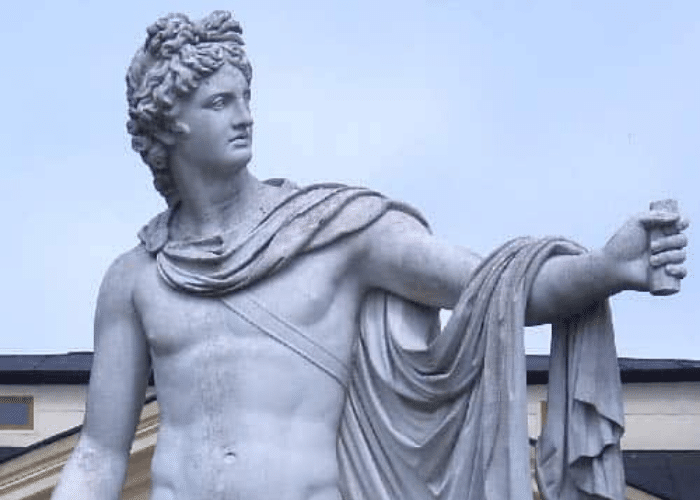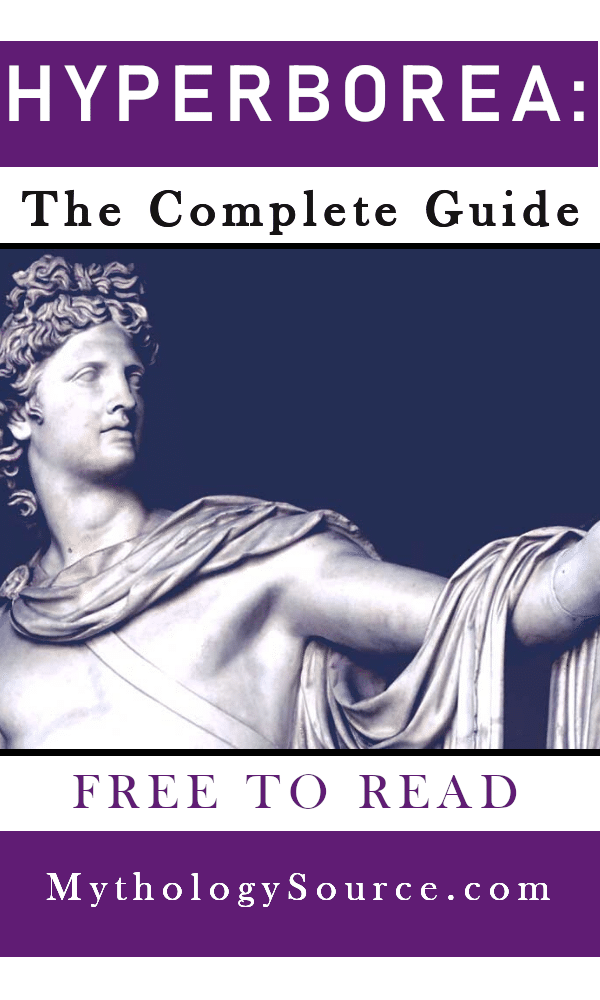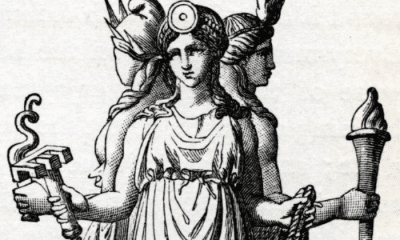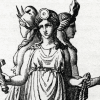
Greek
Hyperborea: What Existed in the Far North According to Greek Legend
Hyperborea: What Existed in the Far North According to Greek Legend
How did the people of Greece see the rest of the world, especially lands that could not be reached by ship? One example is that of Hyperborea, a semi-legendary land of the far north.
The early Greeks had little reason to think about the world beyond the Western Mediterranean. While trade and colonization put them in contact with nearby cultures like the Egyptians and the people of Asia Minor, much of the rest of the world remained a mystery to them.
As trade routes and travel expanded, however, the Greeks came into contact with whole new cultures. Their instinct was to determine how these foreign people fit into their own view of the world.
Most Greeks believed their culture to be inherently superior to others. They not only had law, philosophy, the arts, and military techniques, but their gods were real and powerful.
Those cultures that could not be identified as Greek were considered barbarous, barely human in their strangeness. Even barbarians, however, could be seen as distant relatives of lesser gods or disgraced men.
In some regions, the local gods were readily accepted as slight variations upon the accepted Greek pantheon. The ancient gods of Egypt, for example, were often seen as the deities of Greece with different names and iconography.
Thus, the people of nearby places like Egypt and Turkey were seen as close relatives of the Greeks. Their ancient kings were given Greek origin stories and their cultures were seen as civilised and respectable, if foreign.
In other lands, however, it was more difficult to link foreign cultures to the Greek view of civilization. These people were considered distant kin at best, and subhuman at worst.
One example of this was the Greek view of India. In a late Greco-Roman myth Dionysus waged a war against the exotic Indians to bring the Greek pantheon and wine, an attempt to bring lands reached by Alexander into the established mythology.
Although the Indian subcontinent had ancient and rich cultures, the Greeks considered them uncivilized until they had accepted Greek gods and at least some familiar customs. In the case of the Indian War of Dionysus, the aspect of Greek culture exported to this foreign land was wine.
Sometimes these cultures were so far removed from Greece that they were little more than legend. A few reports and a tenuous mythological link sometimes led writers to think of exotic lands that defied imagination.
One of these cultures was that of the Hyperboreans, residents of a distant northern land of eternal sunlight and spring. Whether Hyperborea was real of a myth, however, is open to interpretation.
Hyperborea Beyond the North Wind
Hyperborea literally translated to “the land beyond Boreas.” Boreas, the god of the North Wind, was thought to live in the northernmost part of Thrace, so the lands beyond him were generally understood to mean those north of that country.
Thrace was on the very edge of the Greek world. Its inhabitants were usually considered barbaric in that they practiced strange rituals, spoke a non-Greek language, and only worshiped a few gods recognized as part of the Greek pantheon.
The lands beyond Thrace, therefore, were completely removed from anything that could be called Greek. Far from the trade routes of the Mediterranean, the far north was uncharted territory.
A few writers described the long trade routes that brought goods like straw and lumber out of this unknown land. Greeks did not travel there themselves, though – the goods of the Hyperboreans passed through Scythia to the Adriatic Sea before making their way to more familiar territories.
The lands beyond the mountains of Boreas, therefore, were known to the Greeks only from rumors. And from those rumors, they imagined a wondrous country.
The Land of the Far North
When we think of the far north of Europe today, we think of a cold land that is marked by long winters. The Greeks, however, imagined a place of eternal spring.
Hyperborea was said to enjoy sunlight all the time, with the goddess Nyx never bringing darkness. Boreas, the North Wind, could not blow his brutal cold into the lands beyond his reach.
Therefore, Hyperborea took on an almost utopian character.
With endless spring and eternal light, Hyperborea was capable of producing two harvests of grain each year with less than half of the work required on a farm in the rocky lands of Greece. Most of the land was left wild, though, with dense forests and green meadows covering the nation.
The Eridanos river flower lazily across the landscape, attracting white swans. Hyperborea was a land of plenty.
It was also a land of peace.
The brutal Rhypaean Mountains in which Boreas made his home made the southern border of Hyperborea impassible by even the heartiest travelers. Cannibal tribes lived in its valleys and griffons guarded the high passes.
The primordial river Oceanus protected the country from the north. While a few Greek sailors had reached the river that encircled the world, none had ever navigated it.
Hyperborea thus had no fear of invading armies because it was protected by natural defenses. Without the constant threat of war, the people lived a peaceful existence that most Greeks could only dream of.
The Inhabitants of Hyperborea
The first kings of the Hyperboreans were said to have been three giant sons of the North Wind himself, Boreas. Later, the country became a theocratic monarchy ruled by three priest-kings of Apollo descended from these first divine rulers.
The god of light was an obvious deity to be worshipped in a land that knew neither the darkness of night nor that of winter. According to Pindar, the Greek hero Perseus was one of the few southerners to ever see that land and was invited to a banquet in the god’s honor.
Yet was it with these [the Hyperboreans] that Perseus the warrior chief once feasted, entering their homes, and chanced upon their sacrifices unto the god, those famous offerings of hecatombs of asses; for in their banquets and rich praise Apollon greatly delights, and laughs to see the rampant lewdness of those brutish beasts.
Nor is the Mousa (Muse) a stranger to their life, but on all sides the feet of maidens dancing, the full tones of the lyre and pealing flutes are all astir; with leaves of gleaming laurel bound upon their hair, they throng with happy hearts to join the revel. Illness and wasting old age visit not this hallowed race, but far from toil and battle they dwell secure from fate’s remorseless vengeance.
-Pindar, Pindar Pythian Ode 10. 27 ff (trans. Conway)
The Greeks eventually came to believe that Apollo spent his winters in Hyperborea, bringing light to that land while Greece endured the darkness of winter. He and Helios were associated with the far north.
The only physical descriptions of the Hyperboreans were of their kings. The descendants of Boreas and the snow nymph Chione were giants, measuring ten feet tall, but generally considered to be without the deformities common in other giant races.
One work compared them to another mythical race that had a single eye, although it’s unknown whether this attribute was believed to be common among the legendary Hyperboreans.
The Hyperboreans were largely thought to be immune from many of the problems that plagued the people of Greece. They did not have to toil to work their fertile lands and disease was unknown to them.
Even the ravages of old age could be escaped. If they aged at all, the elderly Hyperboreans jumped into a lake to be transformed into swans.
The lake was formed by the son of Phaethon, the son of Helios who flew the chariot of the sun too close to earth. The swans that lived there were in honor of his friend Cygnus, while the graceful poplar trees on its banks were his sisters.
The Hyperboreans were separated from Greece, but still knew many of the same gods. Although far removed from Greece itself, they were seen as having enough in common to be considered civilized.
Identification with Real Cultures
By the turn of the millennium, Roman conquest had opened up areas of Europe that had never before been explored by people of the Greek world. While the legendary land of Hyperborea was still thought to exist, it could now be compared to other northern cultures that had only recently been contacted.
As their view of the world expanded, the Greeks came up with many seemingly plausible explanations for who the inhabitants of Hyperborea truly were. The most commonly accepted rationalizations were that the Hyperboreans were the same as, or at least closely related to, some of the many tribes conquered by the Romans in central and northern Europe.
- The Celts – Identifying the Rhypaean Mountains as the Alps, the people to the north were believed to be the Celts. While their lands became well-known to the Romans, the vast forests that covered much of their territory gave some credence to the identification, as did the people’s reputation for feasting and a love of gold.
- The Britons – Several ancient writers described Hyperborea as an island. The fertile land of southern Britain matched descriptions of Hyperborea, and some mentions of a circular altar to Apollo were thought to reference stone circles such as Stonehenge.
- The Gauls – In the 1st century AD, Plutarch specified that the Hyperboreans were not Celts in general, but specifically the tribes of Gaul. He placed them in what is now northern France.
- The Massagetae – Simmias of Rhodes suggested that the Hyperboreans were related to this tribe of nomadic people from Central Asia and Northern Iran. Herodotus further claimed that the Hyperboreans lived beyond the lands of these tribes.
While no known group seemed to perfectly fit the descriptions of the Hyperboreans and their lands, the Greeks and Romans continued to try to identify the legendary people of Boreas.
The Celts themselves were divided on the identification. Some accepted the similarities between their own people and the Greek idea of the Hyperboreans.
Others, like the Celtic tribes of Ireland, had their own mythologies that contradicted those of the Greeks. The Irish believed that they were themselves once ruled by people from farther north, the Tuatha De Dannan, commonly thought of as the Irish gods.
The Animals of Hyperborea
Another noteworthy aspect of Hyperborea, and a possible clue to its location, was its wildlife.
The swans associated with Cygnus were one of the animals associated with the legendary country, but another was even more magnificent.
Heracles was another of the rare Greeks to visit the land of Hyperborea while on his quest to capture the Cerynitian Hind. The golden-horned deer that was sacred to Artemis fled north during the chase, leading Heracles far from Greece.
The deer was eventually captured in Hyperborea, its homeland. But the description of the deer is seen by some historians as an important clue about the location of the myth.
The hind was described as female, but also marked by its golden horns. There are no species of deer native to the regions of Greece in which the females have horns.
To find horned female deer, one must travel much further north than the lands usually identified with Hyperborea. The only species in Europe that matches the description are reindeer.
Reindeer are not native to the regions of Gaul or the island of Britain. They live much further north.
While most commonly associated with Scandinavia, reindeer can also be found in the tundra regions of northern Asia as far as Siberia.
The horned deer might have been a product of the Greek imagination, but its association with the legendary land of the far north leads many to believe that it was originally a reindeer. The Greeks could have learned of the animal from second-hand reports or a specimen brought south from the tundra.
Modern Interpretations
The people of Scandinavia agreed with the idea that they were the true Hyperboreans. In addition to the hind, they pointed to the eternal daylight of the land as evidence.
In some legends, the sun was said to shine twenty fours hours a day in Hyperborea. A few others claimed that it rose and set just once a year.
People of Scandinavia who first heard these tales found them very familiar. Near the Arctic Circle the sun can be visible almost all day in the summer months, and the idea of it rising and setting just once a year could be taken as the extremes between summer and winter there.
An additional description further the Scandinavian claim. The Hyperboreans were described by some writers as looking similar to the mythical Arimaspi, who were usually said to have fair hair and light skin and eyes.
Other modern readers have taken their cues from Herodotus and placed Hyperborea just as far north, but much further west.
Herodotus claimed that the land of the Hyperboreans lay beyond those of the central Asian tribes. Since the nomads covered such a huge amount of territory, this would place Hyperborea in northern Russia, perhaps as far west as Siberia.
Another modern interpretation concludes that no people lived in Hyperborea at all.
The poplar trees on the lakeside in that country were said to drop leaves of amber. The fossilized resin that gives this color its name is most often found in the far northern countries of Europe.
Ancient Greeks saw insects fossilized in amber from the north that were obviously from a warm climate. From this observation, without knowledge of the climatic changes of the prehistoric past, they concluded that the lands to the far north must be warm.
In this view, Hyperborea was a pure invention based on observation of a known northern commodity.
It is, of course, as possible that all of these theories have a grain of truth or that none of them are the reason the Greeks believed the north was a land of long life and eternal sun.
The Legendary Land of Hyperborea
In the Greek view of the wider world, Hyperborea was a land that existed to the far north. Beyond the mountains of the North Wind, it was a land of warm weather and eternal sun.
The kings of Hyperborea were believed to be descended from the sons of Boreas, the North Wind. They were giant men, but no descriptions remain that say whether all the people of the country were believed to be of similar stature.
The people of Hyperborea worshipped Apollo above all other gods. When Perseus travelled to that country he found them to be fond of feasting and dancing in that god’s honor.
The Hyperboreans were believed to live a much easier life than most Greeks. In a land of eternal spring, they lived lives that were both much longer and much less marred by toil, illness, and war.
The Greeks tried to identity the Hyperboreans as their knowledge of the world expanded. They were variously thought to be Celtic people of Gaul or Britain or the western nomadic tribes of Central Asia.
A clue in the legends of Heracles may place Hyperborea far further north than the Roman-era Greeks believed, however. The Cerynitian Hind was described with features that are similar to those of a reindeer, an animal native to the tundras of the far north.
This has led historians from the Middle Ages on to identify Hyperborea with the Arctic lands of Scandinavia. Other interpretations place the land further west, as far away as Siberia.
Whether Hyperborea was an elaboration on a real country or a complete legend may never be known. The clues in ancient writing, however, provide a fascinating glimpse into how the Greeks viewed the world beyond the Mediterranean.




